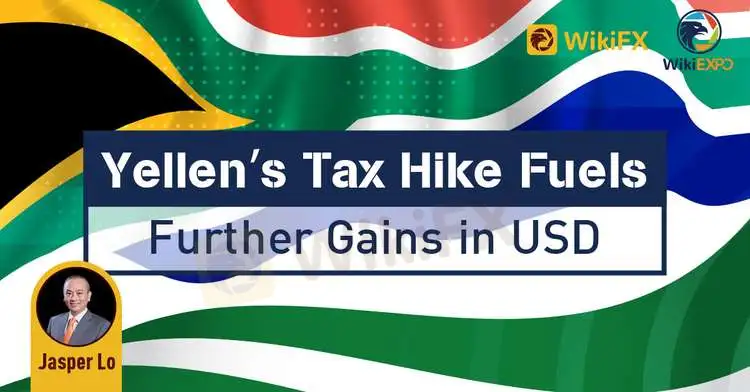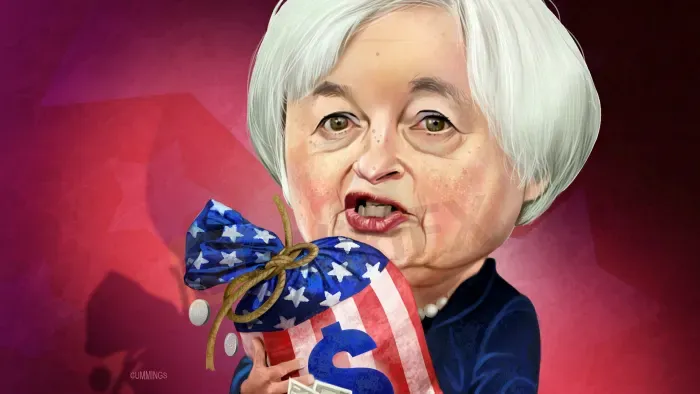简体中文
繁體中文
English
Pусский
日本語
ภาษาไทย
Tiếng Việt
Bahasa Indonesia
Español
हिन्दी
Filippiiniläinen
Français
Deutsch
Português
Türkçe
한국어
العربية
Yellen's Tax Hike Fuels Further Gains in USD| Influencer‘s Insight •Jasper Lo
Abstract:The US 10-Year Treasury yield last Thursday (Mar. 18) significantly retreated to 1.6% after reaching a high of 1.75%. Commonly speaking, a shrinking Treasury yield will punish the US dollar, but the fact is the DXY has rebounded from the low of 91.365 to 92.60. Such a rally has a great deal to do with the US Treasury Secretary Yellen.

The US 10-Year Treasury yield last Thursday (Mar. 18) significantly retreated to 1.6% after reaching a high of 1.75%. Commonly speaking, a shrinking Treasury yield will punish the US dollar, but the fact is the DXY has rebounded from the low of 91.365 to 92.60. Such a rally has a great deal to do with the US Treasury Secretary Yellen. While some analyses indicate the rebound stems from risk aversion as investors turn to the haven-linked dollar and the anti-risk Japanese yen amid geopolitical tensions, I believe the DXY increase is related to Yellen's statement in the congressional hearings
In the face of questions by members in attendance, Yellen said that once the economy was strong again, President Biden was likely to propose that they engaged in long-term plans to address long-standing investment shortfalls in their economy, such as in infrastructure, climate change, etc. One of the proposals to fund the infrastructure program is to increase the corporate income tax rate to 28 percent, which thrusts the financial market into expectations for a tax hike plan. As repeatedly mentioned earlier, the US tax increase could reduce the country's fiscal deficit, boding well for the dollar.

Yellen has been reiterating a bullish economic outlook, forecasting a chance of full employment next year, which refers to an unemployment rate between 4% to5%, compared to the current 6.2%. The financial market is betting that the Fed will position itself to market exit next year. The Fed Chair Powell acknowledged that the country would see inflation rise but the uptick in prices would not be substantial or enduring. He did not signal any intervention in the rising bond yields, nor did he indicate any attempt of Operation Twist, which suggests his acquiescence in the yield boom. With that said, while the 10-Year Treasury yield received some corrections, the DXY, instead of moving at a synchronous pace, embraced a rally.
Along toward the end of Q1, the DXY has gained nearly 3%, while the US 10-Year Treasury yield has surged from 0.9% at the beginning of the year to 1.75%, an increase of 94%. There are streamers asking that at which level will Powell intervene in the swelling bond yields? My answer is the Fed will launch bailouts only when there occurs a stock market crash, rather than a specific yield level. Considering the flourishing Dow, intervention is the last thing Powell considers. In terms of the DXY performance in Q2, I believe it will be better than that in Q1 and could shot up 4% to 5%.
Disclaimer:
The views in this article only represent the author's personal views, and do not constitute investment advice on this platform. This platform does not guarantee the accuracy, completeness and timeliness of the information in the article, and will not be liable for any loss caused by the use of or reliance on the information in the article.
Read more

Key Forex Strategies
New to forex trading and looking for simple and effective trading strategies? We got you covered! In this quick guide, we'll explain some of the key forex strategies which are easy to digest. So, let's start!

Fundamental vs Technical Analysis
Fundamental and technical analysis play some of the most influential and critical roles in making trading decisions amongst traders today. They are widely accepted by stock, foreign exchange, indices and cryptocurrency traders worldwide. Traders use either or both of the methods to make key trading decisions in their respective markets.

Going Short of JPY Is Boosted by Yellen’s Remark on Interest-Rate Hikes Again
When interviewed by Bloomberg, Yellen, the U.S. Treasury Secretary, indicated that the USD 4-trillion budget released by Biden would be beneficial to America even if it may increase inflation and interest rates.

Brent oil is predicted of bullish repricing by Goldman Sach
According to Goldman Sachs' head of energy research, a nuclear deal between the U.S. and Iran could send energy prices higher - even if it means more supply in the oil markets. Talks are ongoing in Vienna between Iran and the six world powers - the U.S., China, Russia, France, U.K., and Germany - trying to salvage the 2015 landmark deal. Officials say there's been progress, but the conclusion of the negotiations remains unclear and oil prices have been soaring as a result.
WikiFX Broker
Latest News
Volkswagen agrees deal to avoid Germany plant closures
Geopolitical Events: What They Are & Their Impact?
Top 10 Trading Indicators Every Forex Trader Should Know
TradingView Launches Liquidity Analysis Tool DEX Screener
MultiBank Group Wins Big at Traders Fair Hong Kong 2024
WikiEXPO Global Expert Interview: Simone Martin—— Exploring Financial Regulation Change
'Young investors make investment decisions impulsively to keep up with current trends' FCA Reveals
Why Do You Feel Scared During Trade Execution?
CySEC Settles Compliance Case with Fxview Operator Charlgate Ltd
Scope Markets Review: Trustworthy or Risky?
Currency Calculator


